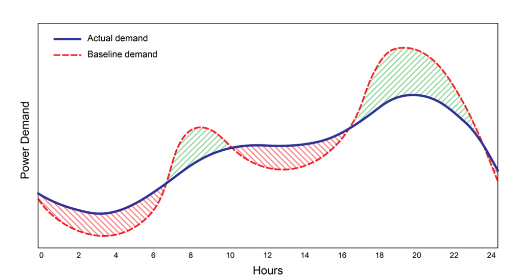2.3.2 Lecture Notes Use of Demand Flexibility
Course subject(s)
2. Flexibility Through Energy Storage & Demand Side Management
This image is from freepik
Currently, we are used to electricity simply being there when it is needed, for example you can turn on the washing machine whenever you need to do your laundry. However, on the other side of the socket, there happens a lot to make sure everyone receives the energy needed. At some times this is easier than other times, for example when PV panels produce much electricity compared to period with no sun or wind.
The energy system can be more efficient if supply is not only matched at demand, but demand is also matched with supply. This means that, if possible, energy should be used when it is available.
This lecture explains different aspects of flexible energy demand and the following topics are discussed:
- The concept of flexible energy demand
- Different ways in which demand can be flexible
- Characterisations of a demand response program
- The measurement of realised flexibility
The concept of flexible energy demand
Flexible energy demand is the ability to change energy consumption patterns in such a way that this change benefits the energy system. This is also known as demand response or demand side management. An example of this flexibility is charging electric vehicles during off-peak hours instead of charging it immediately after arriving home. Another form of flexibility is saving laundry to wash it when this is the most beneficial for the energy system. This shows that there are many non-technical aspects involved in demand flexibility.
Different ways in which demand can be flexible
Generally, there are three main ways in which the demand can be flexible. The simplest form is to change the consumption of energy, which would typically be a reduction. An example is to compromise on temperature comfort if the cost of heating or cooling becomes very high.
The second type of flexibility is to shift the demand in time. This happens when some of the activities are shifted to off-peak hours, such as the example of electric vehicles.
The last type of flexibility is to switch to a different energy source. As an example, a local generator can be used, when the price of the electricity becomes too high.
Characterisations of a demand response program
The flexibility in demand can only exist if there is a way to communicate the energy system preferences to the energy consumers. In practice, this is done by a variety of control mechanisms, which can be characterized by three aspects. The first aspect is the control setup, which is how users decide to change their demand. This can be done in a centralized manner, where the service provider directly controls the charging of vehicles for example, or in a decentralized manner, where the vehicle autonomously aligns its charging pattern with low-cost periods.
The second aspect is the variety of motivations that can be used. Often people assume the main motivation is financial, but there is evidence that people are also willing to change their consumption to help the environment.
The third aspect in which demand responses can be characterized is the notice period. This means how much in advance consumers are informed when a change in energy consumption is desired. At one extreme, this can mean that there are fixed schedules for off-peak hours. At the other extreme, there are real-time prices or real-time control signals to communicate an urgent issue in the energy supply.
The measurement of realised flexibility
After flexibility has been defined and control mechanisms are used to activate the flexibilities, it is also important to quantify the amount by consumers change their consumption patterns. This can be done by measuring the difference between the actual demand and the demand without a demand response program, which is known as counterfactual. The main problem for measuring this, is the fact that it is unknown what the demand would have been without the demand response program.
There are different methods to estimate the demand without demand response. This can be done by using historical data or a carefully controlled trial setup. This estimation is called the baseline demand. In the figure below, it can be concluded that the flexibility in demand has been succeeded. By comparing the graphs, it can be seen that the peaks have been shaved and the valleys have been filled.
Conclusion
This lecture gave a brief introduction to the field of flexible energy demand. First the concept has been discussed, which is followed by the different ways in this can be realized. Also, three characteristics of flexible demands have been discussed. Finally, it was explained how baselines can be used to measure the flexibility.

Technology of Intelligent and Integrated Energy Systems by TU Delft OpenCourseWare is licensed under a Creative Commons Attribution-NonCommercial-ShareAlike 4.0 International License.
Based on a work at https://online-learning.tudelft.nl/courses/technology-of-intelligent-and-integrated-energy-systems/




